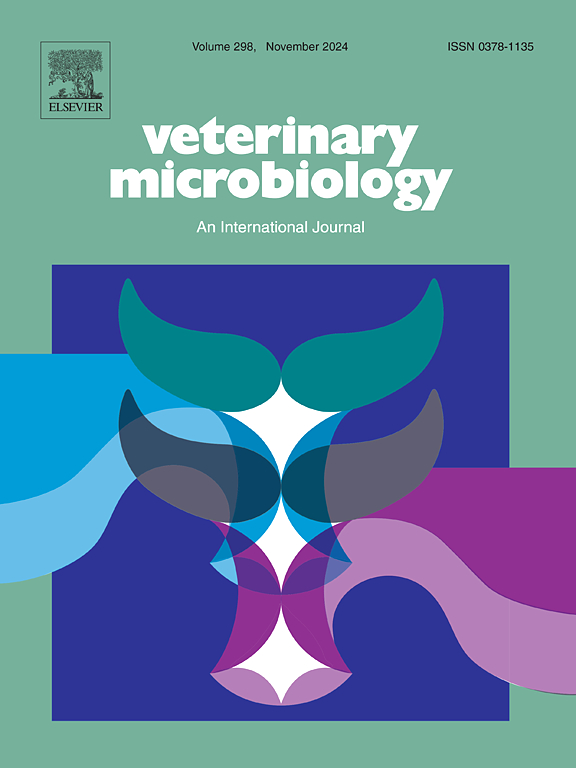Identification of three novel linear B-cell epitopes on VP7 of African horse sickness virus using monoclonal antibodies
IF 2.4
2区 农林科学
Q3 MICROBIOLOGY
引用次数: 0
Abstract
African horse sickness (AHS) is an acute and subacute infectious disease of equine species caused by the African horse sickness virus (AHSV). The VP7 of AHSV is a group-specific protein conserved in all serotypes and is an excellent candidate for the serological diagnosis and an AHS vaccine component. However, to date, B-cell epitopes on the AHSV VP7 recognized by humoral immune responses remain unclear. This study expressed the recombinant AHSV VP7 soluble in Escherichia coli and purified it for mouse immunization. Four monoclonal antibodies (mAbs) were screened and identified by hybridoma cell fusion, clonal purification, and immunological assays. The B-cell epitopes, recognized by monoclonal antibodies 4B5, 3G10, 3D7, and 4D6, were identified by a series of truncated overlapping peptides expressed as glutathione S-transferase (GST)-fusion proteins. The results revealed that 4B5 recognized the 124VQTGRYAGA132 motif, 3G10 recognized the 140RYYVPQGRT148 motif, while 3D7 and 4D6 recognized the 292QPINPPIFP300 motif. Amino acid sequence alignment indicated that three novel B-cell epitopes were conserved among various AHSV serotypes but unconserved in other orbiviruses, such as the bluetongue and epidemic hemorrhagic disease viruses. This study informs on the antigenic epitopes of AHSV VP7, facilitating future investigations into the serological diagnosis method and epitope-based vaccines against AHSV.
利用单克隆抗体鉴定非洲马瘟病毒 VP7 上的三个新型线性 B 细胞表位
非洲马瘟(AHS)是由非洲马瘟病毒(AHSV)引起的马科动物的一种急性和亚急性传染病。非洲马瘟病毒的 VP7 是一种在所有血清型中都保留下来的群体特异性蛋白,是血清学诊断和非洲马瘟疫苗成分的绝佳候选蛋白。然而,迄今为止,体液免疫反应识别的 AHSV VP7 上的 B 细胞表位仍不清楚。本研究在大肠杆菌中表达了可溶性重组 AHSV VP7,并将其纯化用于小鼠免疫。通过杂交瘤细胞融合、克隆纯化和免疫测定,筛选并鉴定了四种单克隆抗体(mAbs)。单克隆抗体 4B5、3G10、3D7 和 4D6 识别的 B 细胞表位是通过一系列截短的重叠肽鉴定的,这些肽表达为谷胱甘肽 S 转移酶(GST)融合蛋白。结果显示,4B5 识别 124VQTGRYAGA132 主题,3G10 识别 140RYYVPQGRT148 主题,而 3D7 和 4D6 识别 292QPINPPIFP300 主题。氨基酸序列比对表明,三种新型 B 细胞表位在 AHSV 不同血清型中是保守的,但在蓝舌病病毒和流行性出血病病毒等其他眼病毒中则是不保守的。这项研究为研究 AHSV VP7 的抗原表位提供了信息,有助于今后研究 AHSV 的血清学诊断方法和基于表位的疫苗。
本文章由计算机程序翻译,如有差异,请以英文原文为准。
求助全文
约1分钟内获得全文
求助全文
来源期刊

Veterinary microbiology
农林科学-兽医学
CiteScore
5.90
自引率
6.10%
发文量
221
审稿时长
52 days
期刊介绍:
Veterinary Microbiology is concerned with microbial (bacterial, fungal, viral) diseases of domesticated vertebrate animals (livestock, companion animals, fur-bearing animals, game, poultry, fish) that supply food, other useful products or companionship. In addition, Microbial diseases of wild animals living in captivity, or as members of the feral fauna will also be considered if the infections are of interest because of their interrelation with humans (zoonoses) and/or domestic animals. Studies of antimicrobial resistance are also included, provided that the results represent a substantial advance in knowledge. Authors are strongly encouraged to read - prior to submission - the Editorials (''Scope or cope'' and ''Scope or cope II'') published previously in the journal. The Editors reserve the right to suggest submission to another journal for those papers which they feel would be more appropriate for consideration by that journal.
Original research papers of high quality and novelty on aspects of control, host response, molecular biology, pathogenesis, prevention, and treatment of microbial diseases of animals are published. Papers dealing primarily with immunology, epidemiology, molecular biology and antiviral or microbial agents will only be considered if they demonstrate a clear impact on a disease. Papers focusing solely on diagnostic techniques (such as another PCR protocol or ELISA) will not be published - focus should be on a microorganism and not on a particular technique. Papers only reporting microbial sequences, transcriptomics data, or proteomics data will not be considered unless the results represent a substantial advance in knowledge.
Drug trial papers will be considered if they have general application or significance. Papers on the identification of microorganisms will also be considered, but detailed taxonomic studies do not fall within the scope of the journal. Case reports will not be published, unless they have general application or contain novel aspects. Papers of geographically limited interest, which repeat what had been established elsewhere will not be considered. The readership of the journal is global.
 求助内容:
求助内容: 应助结果提醒方式:
应助结果提醒方式:


